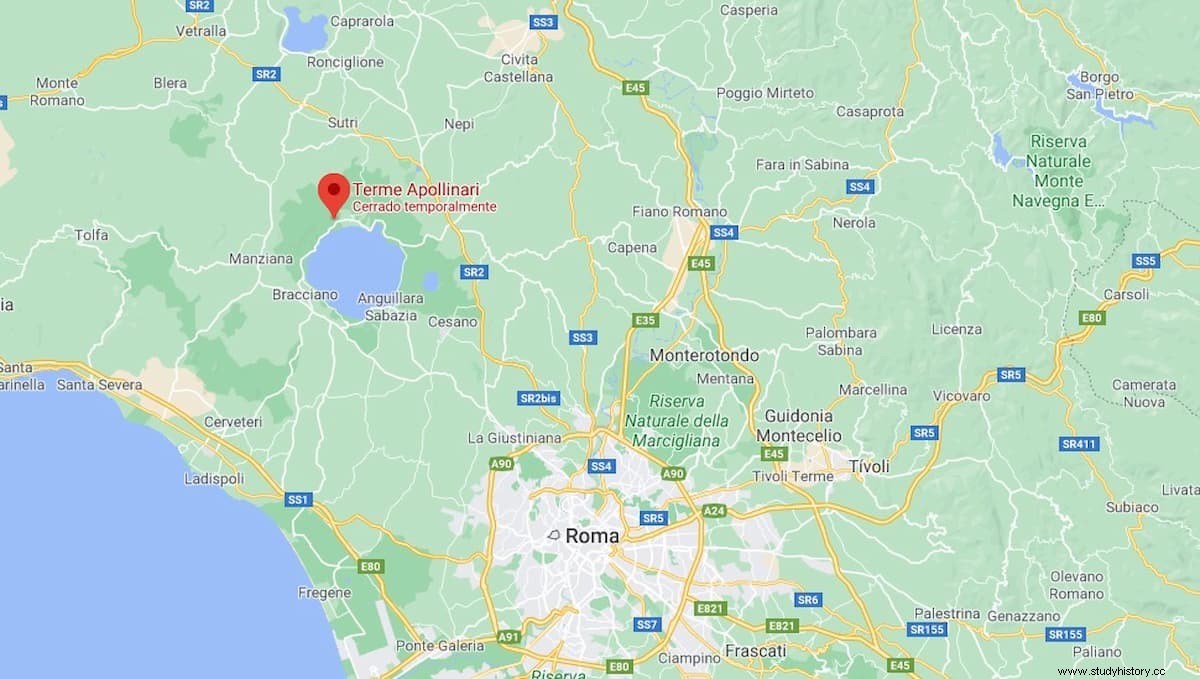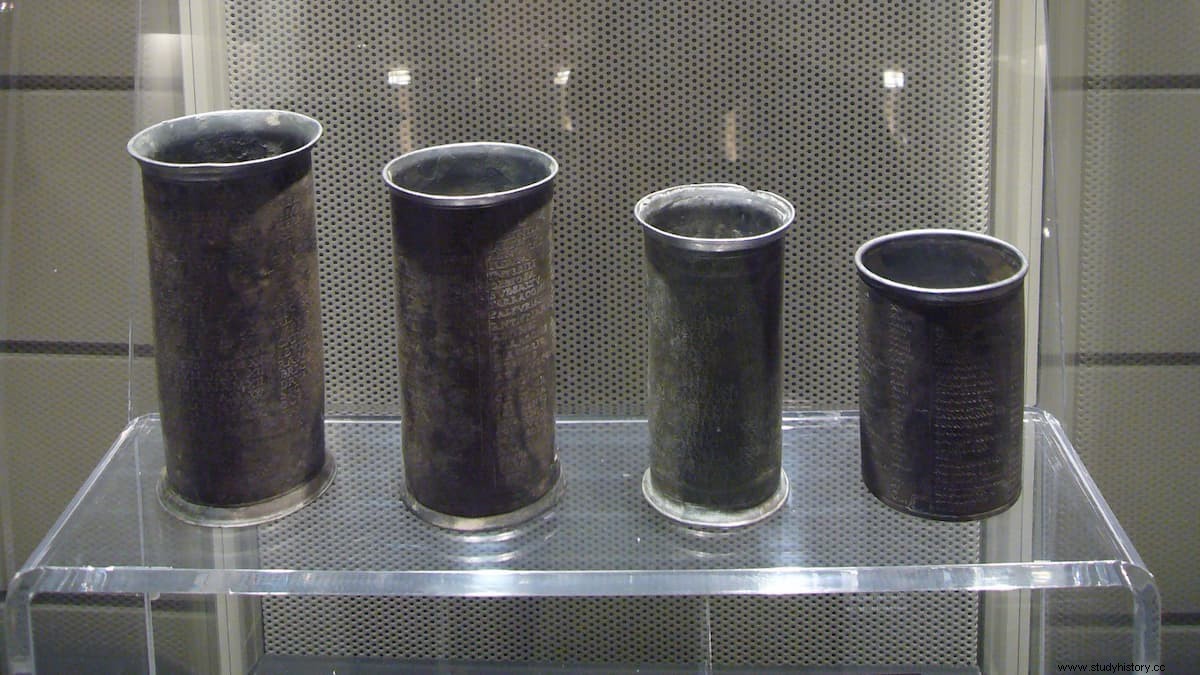The Romans created, since the Republican era and throughout the existence of the Empire, an impressive and extensive network of roads that connected the different and remote parts of their domains, from Britain to Egypt, and from Dacia to North Africa. .
Thus, for example, a citizen of Gades (Cádiz) on the Iberian Peninsula could reach Rome without abandoning a Roman road, and there were also itineraries which were a kind of road maps where the names of the places through which the road passed were represented, as well as the distances between them. There are several examples of documents of this type, such as the Antonine Itinerary (3rd century), the so-called Clay Itinerary (3rd century) or the Peutingerian Table (4th century).

Another one of those itineraries it is even more curious, because it is inscribed on four silver vessels in the shape of milestones (the cylindrical columns that were placed on the roads to mark the Roman miles). They are known as Apollinarian Vessels or Vicarello glasses , precisely because they appeared in the Apollinari baths (Aquae Apollinares ) from the town of Vicarello next to Lake Bracciano (former Lake Sabatinus), about 32 kilometers northwest of Rome.
And not only is it curious because of that, but also, the itinerary that is inscribed is the one that leads from the city of Gades (Cádiz) to Rome, constituting material evidence of the example that we gave before, the Cadiz traveler who travels to Rome using the system of Roman roads (traveling about 2,780 kilometers), and that he probably left the vessels as an offering or ex-voto in the temple next to the baths.

The itinerary consists of the list of the 104 towns, or stops, through which the route passed following the Via Augusta, with an indication of the distances in Roman miles between them. The total comprises some 1,841 Roman miles, the Roman mile being the distance traveled with a thousand steps (and each Roman step would be 2 of ours, since they counted the full stride cycle as a step), approximately 1.48 kilometers.
Each vessel repeats the same itinerary, in panels framed by columns or pilasters with Corinthian capitals, with small differences in distance between each one, which would mean that they were made at different times. Each of the glasses has a different height, the smallest being 9.50 centimeters and the largest 15.30. All of them have a diameter between 6.7 and 7.7 centimeters.

The part of the route that runs through the Iberian Peninsula lists the following locations:Ad Portum (Castillo de Doña Blanca, Jerez de la Frontera) – Hasta (Mesas de Asta, Jerez de la Frontera) – Ugia – Orippo (Torre de los Herberos) – Hispalim (Sevilla) – Carmone (Carmona) – Obucla (Monclova) – Astigi (Écija) – Ad Aras – Corduba (Córdoba) – Ad Decumo – Epora (Montoro) – Uciese (Marmolejo) – Ad Novlas – Castulone ( Linares) – Ad Morum (Navas de San Juan) – Ad Duo Solaria (Zadorio) – Mariana (Puebla del Príncipe) – Mentesa (Villanueva De la Fuente) – Libisosa (Lezuza) – Parietinis (Pareazos Viejos) – Saltigi (Chinchilla) – Ad Palem – Ad Aras – Saetabi (Xátiva) – Sucrone (Alcira) – Valentia (Valencia) – Sagyntu (Sagunto) – Ad Novlas – Ildum (Cabanes) – Intibili – Dertosa (Tortosa) – Sub Saltu (Coll de Balaguer) – Tarracone (Tarragona) – Palfuriana – Antistiana – Ad Fines – Arragonem (Sabadell) – Semproniana – Seterras (Breda) – Aquis Vocontis (Caldes de Malavella) – Gerunda (Gi rona) – Cilniana – Iuncaria (Figueres) – In Pyrinaeo (Coll de Perthus) .
Three of the vessels were discovered in 1852 among the remains of a temple of Apollo next to the Aquae Apollinares baths. , in a crack in the rock from which the water flowed, mixed with other precious objects such as 5,000 bronze coins of Greek, Etruscan and Roman origin, 34 vessels (3 of them gold and 25 silver), and various objects and statues of metal, in what until now is considered the greatest treasure of Antiquity found in Roman territory. All of these were offerings made to Apollo in that place since ancient times. The fourth appeared in the same place in 1863, eleven years after the other three.

They were made in Gades, according to some specialists, in the 1st century AD. and according to others towards the end of the 3rd century or the beginning of the 4th century AD, and constitute an important source for knowing the geography of the Roman Empire. According to Lidio Gasperini, from the University of Rome, if the devout offerer of the vases must have been from Cadiz, the workshop where they were cast and where the punch inscriptions were made must also have been from Cadiz .
None of the vases includes in the itinerary the town of Vicarello where they were found, but the route actually passes several tens of kilometers to the east, through places such as Narnia (present-day Narni) and Ocriculum (present-day Otricoli). One hypothesis says that the cups could have been an offering from Cadiz merchants in gratitude for the trip made to Rome for business, but it leaves unresolved the question of why they would choose the land route instead of the less expensive and faster sea route. 
Another hypothesis explains that the vases could have been donations from Hispanic travelers to Senator Lucio Juno Cesenio Peto, a relative of Emperor Domitian, who had a villa in Vicarello. An alternative hypothesis is the well-known legend of the man from Cadiz who traveled to Rome just to meet the historian Tito Livio, echoed by Pliny the Younger:

And we must not forget that during the reign of Domitian there lived in Rome a poet born in Cádiz, named Julio Canio Rufo, who rubbed shoulders with Marcial and Tito Livio, and whom the latter reprimanded for how much he liked dealing with the ladies .
Today the vessels are preserved in the National Roman Museum, in the Massimo alle Terme Palace in Rome, while reproductions of them can be seen in the Royal Academy of History in Madrid.
